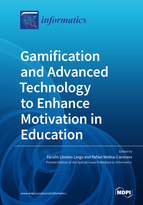Gamification and Advanced Technology to Enhance Motivation in Education
A special issue of Informatics (ISSN 2227-9709).
Deadline for manuscript submissions: closed (30 June 2019) | Viewed by 100871
Special Issue Editors
Interests: artificial intelligence; video game development; gamification; application of digital technologies to education and IT governance
Interests: artificial intelligence applications in different fields: computer-aided design and manufacturing, computer graphics, learning, creativity, information representation and IT governance
Special Issue Information
Dear colleagues,
Motivation is the driving force behind many human activities, particularly learning. Motivated students are ready to make a significant mental effort and use deeper and more effective learning strategies. Some of the fundamental attributes of learning strategies that enhance motivation are:
- Experimentation or learning by doing.
- Interactivity and immediate feedback.
- Allow and naturalize the error.
- Give control to the learner.
Gamification is a means to obtain motivation by incorporating the use of strategies, models, dynamics, mechanics and game elements in a learning context. But it is not the only way. Other technologies can provide users with motivation by introducing the aforementioned learning strategies.
This Special Issue aims to promote innovative ideas, theories, models, approaches, technologies, systems, projects, best practices, case studies, ethical studies and products in the area of advanced technologies to enhance motivation in education. Submissions should present empirical and/or theoretical advances on (but not limited to) the following topics:
- Gamification
- Serious games
- Game design applied to education
- Smart learning
- Adaptive learning
- Advanced interfaces for learning
Prof. Dr. Faraón Llorens-Largo
Prof. Dr. Rafael Molina-Carmona
Guest Editors
Manuscript Submission Information
Manuscripts should be submitted online at www.mdpi.com by registering and logging in to this website. Once you are registered, click here to go to the submission form. Manuscripts can be submitted until the deadline. All submissions that pass pre-check are peer-reviewed. Accepted papers will be published continuously in the journal (as soon as accepted) and will be listed together on the special issue website. Research articles, review articles as well as short communications are invited. For planned papers, a title and short abstract (about 100 words) can be sent to the Editorial Office for announcement on this website.
Submitted manuscripts should not have been published previously, nor be under consideration for publication elsewhere (except conference proceedings papers). All manuscripts are thoroughly refereed through a single-blind peer-review process. A guide for authors and other relevant information for submission of manuscripts is available on the Instructions for Authors page. Informatics is an international peer-reviewed open access quarterly journal published by MDPI.
Please visit the Instructions for Authors page before submitting a manuscript. The Article Processing Charge (APC) for publication in this open access journal is 1800 CHF (Swiss Francs). Submitted papers should be well formatted and use good English. Authors may use MDPI's English editing service prior to publication or during author revisions.
Keywords
- Gamification
- Serious games
- Educational games
- Game design
- Smart learning
- Adaptive learning
- Personalized learning
- Virtual reality
- Augmented reality
- Natural language interfaces
- Intelligent tutoring
- Motivation
- Collaborative learning
- Social networks
- Ubiquitous learning
- E-learning.
- Smart evaluation
- Automatic evaluation
- Automatic feedback
- Learning style assessment
- Smart classrooms
- Smart products for learning







